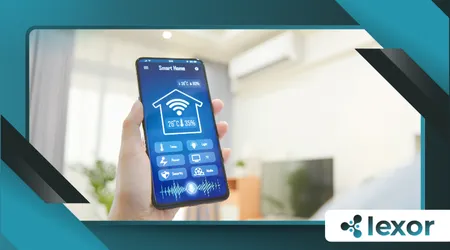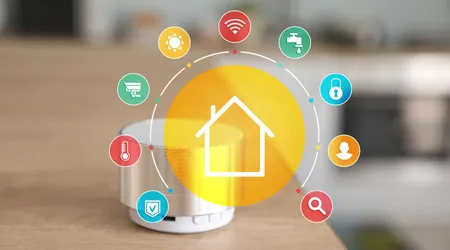How Voice Assistants are Revolutionizing Home Automation

Voice assistants are no longer a futuristic concept—they are now at the heart of modern home automation, transforming how we interact with our living spaces.
From adjusting thermostats to managing security systems, these intelligent tools are redefining convenience, efficiency, and accessibility in smart homes.
But how exactly are they reshaping the landscape of home automation, and what does this mean for the future of our daily lives?
As these technologies continue to evolve, they are becoming more integrated into our lives, allowing for seamless control of various devices.
The ability to use natural language for commands means that even those who are not tech-savvy can enjoy the benefits of smart home technology.
Rise of Voice-Controlled Smart Homes
The integration of voice assistants into home automation systems has been nothing short of revolutionary.
According to a 2023 report by Statista, over 35% of U.S. households now use voice-controlled devices, a number expected to grow as technology becomes more affordable and intuitive.
This surge in adoption is driven by the seamless interaction these devices offer, allowing users to control lights, appliances, and even entertainment systems with simple voice commands.
Moreover, the rise of smart speakers has made these technologies more accessible.
Devices like Amazon Echo and Google Home are now commonplace, serving as central hubs for controlling multiple smart home devices.
What sets voice assistants apart is their ability to learn and adapt.
Unlike traditional remote controls or smartphone apps, these systems use natural language processing (NLP) to understand context and preferences.
For instance, saying, “I’m cold,” can prompt your assistant to adjust the thermostat, while “Movie night” might dim the lights and queue up your favorite streaming service.
This level of personalization is pushing home automation into uncharted territory.
As users become more familiar with their voice assistants, they often discover new functionalities.
This ongoing exploration fosters a sense of ownership and engagement with technology, making users feel more connected to their smart homes.
+ Energy-efficient smart homes: savings through technology
Enhancing Accessibility and Inclusivity
One of the most significant impacts of voice assistants in home automation is their role in making smart homes more accessible.
For individuals with mobility challenges or visual impairments, voice-controlled systems provide a level of independence that was previously unattainable.
Instead of relying on physical switches or touchscreens, users can manage their environment effortlessly through spoken commands.
This inclusivity extends beyond physical limitations.
Voice assistants are also bridging the gap for those less familiar with technology.
Older adults, for example, may find it easier to speak to a device than navigate a complex app.
By simplifying interactions, these tools are democratizing access to smart home technology.
Additionally, the ability to customize voice commands can further enhance usability for different demographics.
For instance, family members can set up personalized wake words or phrases that resonate with their unique needs, making the technology feel more intuitive.
Energy Efficiency and Sustainability
Voice assistants are also playing a pivotal role in promoting energy efficiency.
Smart thermostats like Nest or Ecobee, when paired with voice control, allow users to optimize heating and cooling based on real-time needs.
A simple command like, “Set the temperature to 72 degrees,” can reduce energy waste, while routines like “Goodnight” can turn off all lights and lower the thermostat automatically.
The environmental benefits are substantial.
A study by the American Council for an Energy-Efficient Economy (ACEEE) found that smart home systems, including those powered by voice assistants, can reduce household energy consumption by up to 15%.
This not only lowers utility bills but also contributes to broader sustainability goals.
Moreover, the integration of voice assistants with other smart devices can create a comprehensive energy management system.
For example, users can receive alerts about energy usage patterns, empowering them to make informed decisions about their consumption.
Security and Peace of Mind
Home security has also seen a dramatic transformation thanks to voice-enabled automation.
Systems like Ring and Arlo integrate seamlessly with voice assistants, allowing users to monitor cameras, lock doors, and receive alerts through simple commands.
“Show me the front door” can instantly display a live feed on your smart display, while “Lock all doors” ensures your home is secure without lifting a finger.
This hands-free control is particularly valuable in emergencies.
Imagine a scenario where you’re carrying groceries and notice something suspicious.
Instead of fumbling for your phone, a quick voice command can activate your security system, providing immediate peace of mind.
Additionally, many security systems now offer real-time alerts through voice assistants, keeping users informed of any unusual activity.
This proactive approach enhances overall safety and allows for quicker responses in critical situations.

The Role of AI and Machine Learning
At the core of voice assistants is artificial intelligence (AI), which enables them to improve over time.
Machine learning algorithms analyze user behavior, preferences, and even speech patterns to deliver more accurate and personalized responses.
This continuous learning process ensures that the system evolves alongside your needs.
For example, if you frequently ask your assistant to play jazz music in the evenings, it might start suggesting playlists or adjusting the lighting to match the mood.
This proactive approach not only enhances user experience but also deepens the integration of voice assistants into daily life.
As AI technology advances, we can expect voice assistants to become even more intuitive.
Future updates may allow for more complex tasks, such as managing schedules or providing reminders based on user habits, further integrating them into our routines.
Challenges and Considerations
Despite their many advantages, voice assistants in home automation are not without challenges.
Privacy concerns remain a significant issue, as these devices are always listening for their wake words.
While companies like Amazon and Google have implemented measures to protect user data, the potential for misuse or hacking cannot be ignored.
Interoperability is another hurdle.
With multiple brands and ecosystems available, ensuring that all your devices work seamlessly together can be tricky.
However, initiatives like Matter, a new smart home standard, aim to address this by creating a unified framework for device communication.
Furthermore, educating users about privacy settings and best practices can help mitigate concerns.
Encouraging users to regularly review their privacy settings ensures that they remain in control of their data and usage.
++ Smart Home Essentials: Complete Setup Guide 2025
The Future of Voice-Controlled Homes
Looking ahead, the potential for voice assistants in home automation is virtually limitless.
Advances in AI and IoT (Internet of Things) are paving the way for even more sophisticated interactions.
Imagine a home that not only responds to your commands but anticipates your needs.
For instance, your assistant might notice you’re running late for work and suggest the fastest route, while simultaneously adjusting your home’s settings for the day.
Moreover, the integration of voice assistants with augmented reality (AR) and virtual reality (VR) could open up entirely new possibilities.
Picture a scenario where you’re redecorating your living room and use voice commands to visualize different furniture arrangements in real-time.
As these technologies converge, we may see the emergence of fully immersive smart home experiences.
This could revolutionize how we interact with our spaces, making everyday tasks more engaging and efficient.
Tables: Key Insights on Voice Assistants and Home Automation
| Aspect | Impact |
|---|---|
| Accessibility | Enables hands-free control for individuals with mobility or visual impairments. |
| Energy Efficiency | Reduces household energy consumption by up to 15%. |
| Security | Provides real-time monitoring and control through voice commands. |
| Personalization | Uses AI to learn user preferences and adapt over time. |
| Voice Assistant Usage | Statistics |
|---|---|
| U.S. Household Adoption | Over 35% of households use voice-controlled devices (Statista, 2023). |
| Energy Savings | Smart home systems can cut energy use by 10-15% (ACEEE). |
| Privacy Concerns | 47% of users worry about data security with voice assistants (Pew Research). |
Conclusion
Voice assistants are undeniably revolutionizing home automation, offering unparalleled convenience, accessibility, and efficiency.
As technology continues to evolve, these tools will become even more integrated into our daily lives, transforming our homes into truly intelligent spaces.
However, as we embrace this future, it’s crucial to address challenges like privacy and interoperability to ensure these systems remain secure and user-friendly.
The era of voice-controlled smart homes is here, and it’s only just beginning.
Whether you’re a tech enthusiast or a casual user, there’s no denying the transformative power of voice assistants in shaping the way we live.
As we move forward, staying informed about advancements and best practices will help maximize the benefits of these technologies.
Embracing change with a proactive mindset will ensure that we harness the full potential of voice assistants in our homes.
